Corporate Accounting Analysis: Ramsay Health Care Limited Report
VerifiedAdded on 2020/05/28
|10
|2088
|50
Report
AI Summary
This report provides a detailed analysis of the corporate accounting practices of Ramsay Health Care Limited. It examines the components of equity, including issued capital, treasury shares, and retained earnings, highlighting the changes in equity value between 2015 and 2016. The report also delves into the income tax expenses, comparing the amounts paid and payable, and explores the factors influencing these figures. Furthermore, it analyzes the deferred tax assets and liabilities, noting the changes in their values over the same period. The report investigates the differences between income tax expense and income tax paid, explaining the accounting treatments and the impact of timing differences. Finally, it assesses the treatment of tax in the financial statements, emphasizing the segmentation, detailed explanations in notes, and reconciliation of tax expenses. The analysis is supported by references to accounting standards and academic literature.
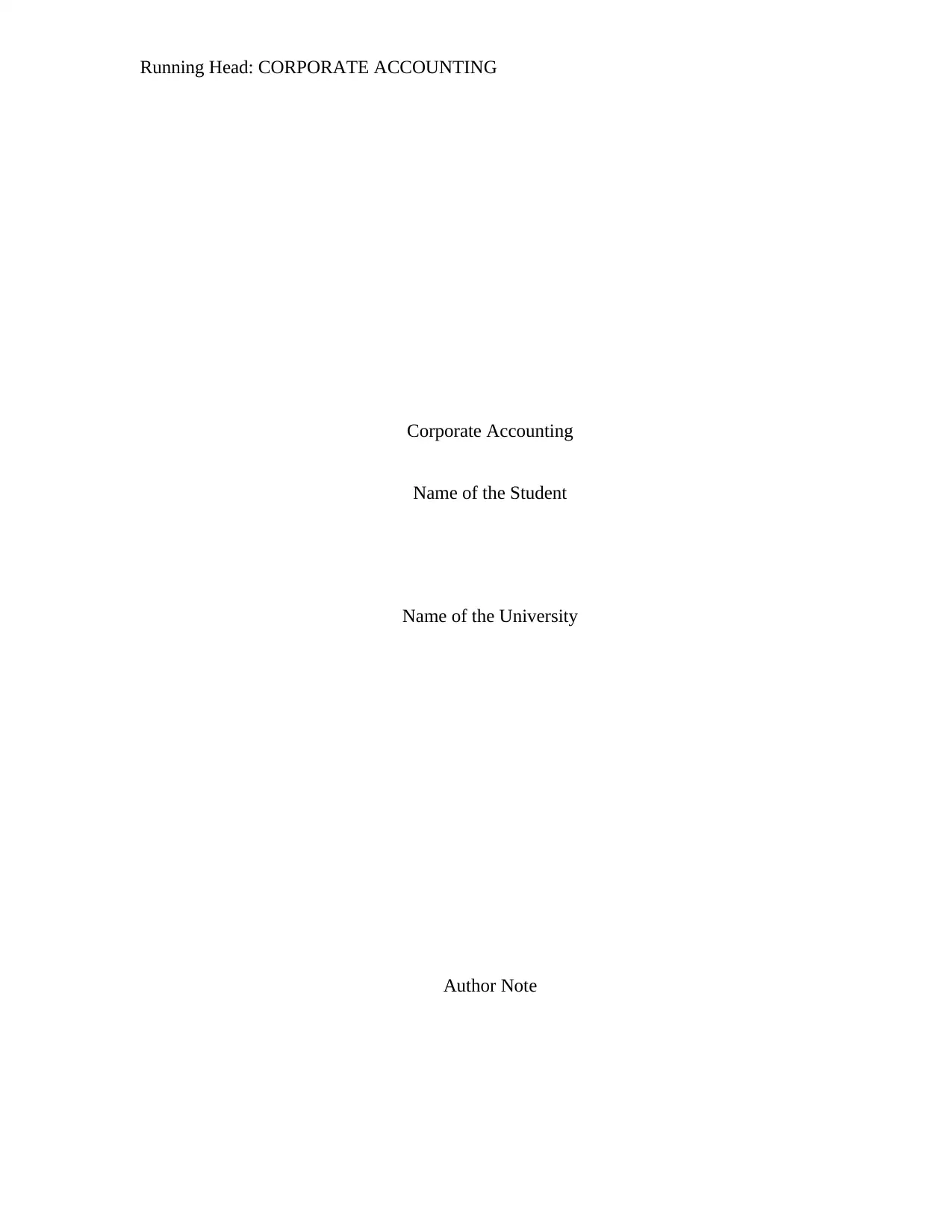
Running Head: CORPORATE ACCOUNTING
Corporate Accounting
Name of the Student
Name of the University
Author Note
Corporate Accounting
Name of the Student
Name of the University
Author Note
Paraphrase This Document
Need a fresh take? Get an instant paraphrase of this document with our AI Paraphraser
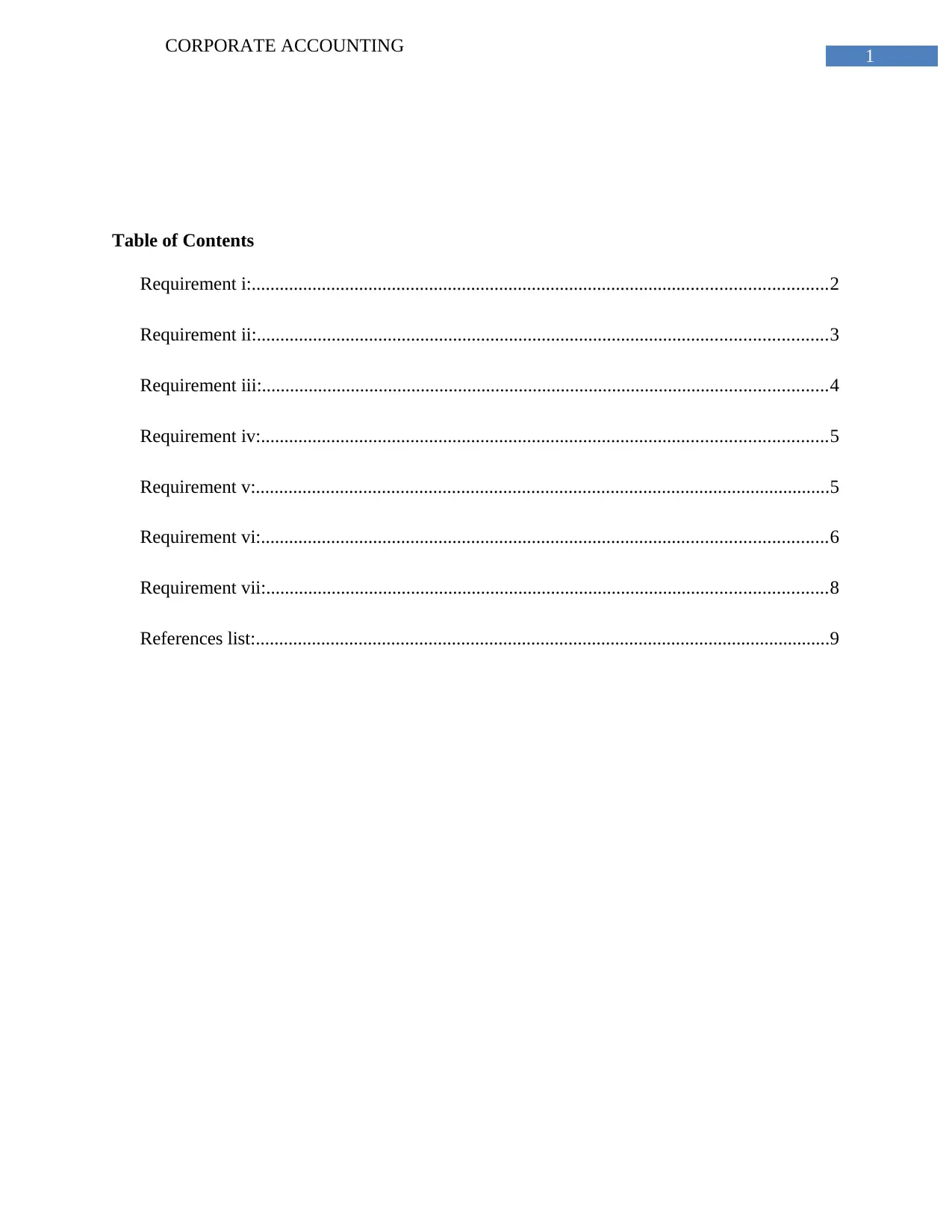
1
CORPORATE ACCOUNTING
Table of Contents
Requirement i:...........................................................................................................................2
Requirement ii:..........................................................................................................................3
Requirement iii:.........................................................................................................................4
Requirement iv:.........................................................................................................................5
Requirement v:...........................................................................................................................5
Requirement vi:.........................................................................................................................6
Requirement vii:........................................................................................................................8
References list:...........................................................................................................................9
CORPORATE ACCOUNTING
Table of Contents
Requirement i:...........................................................................................................................2
Requirement ii:..........................................................................................................................3
Requirement iii:.........................................................................................................................4
Requirement iv:.........................................................................................................................5
Requirement v:...........................................................................................................................5
Requirement vi:.........................................................................................................................6
Requirement vii:........................................................................................................................8
References list:...........................................................................................................................9
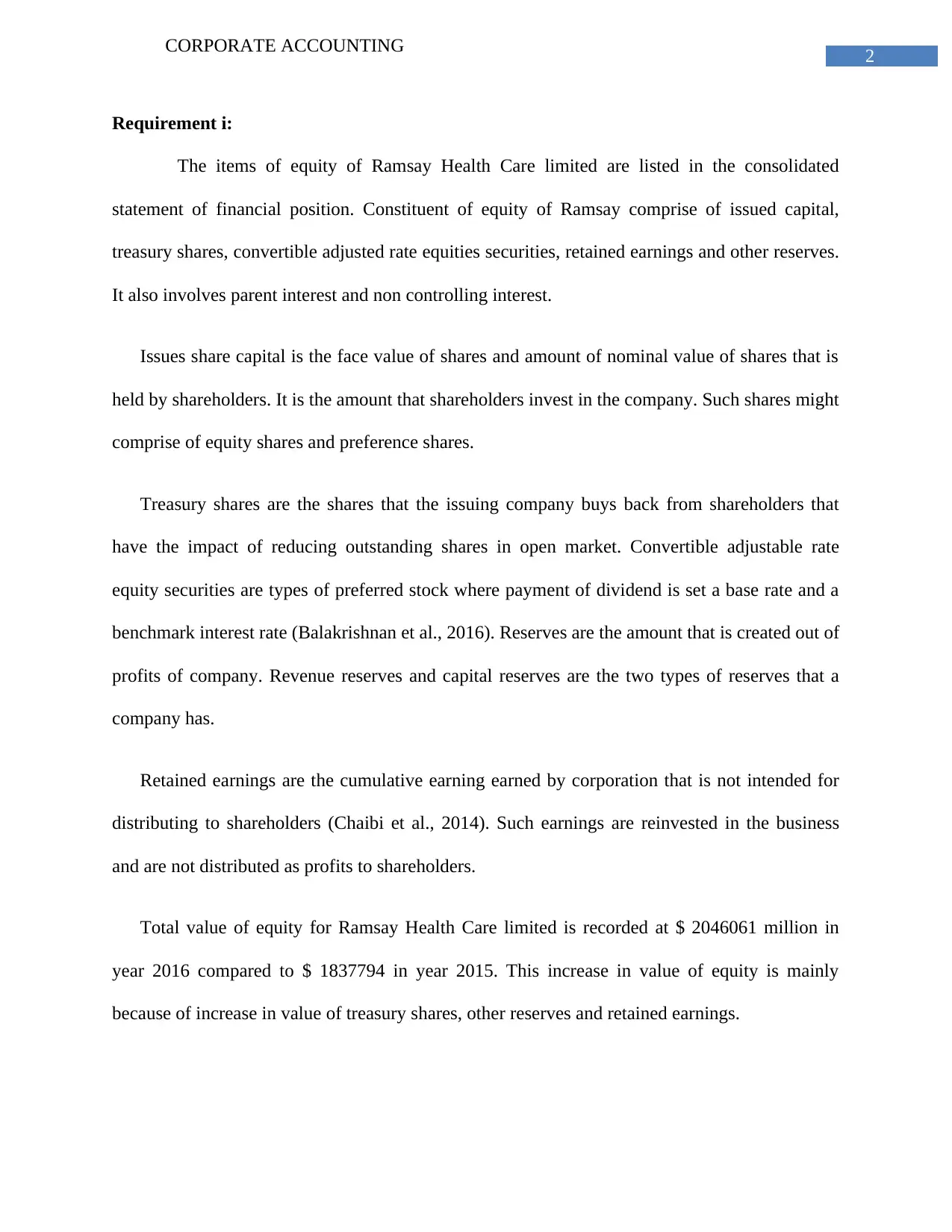
2
CORPORATE ACCOUNTING
Requirement i:
The items of equity of Ramsay Health Care limited are listed in the consolidated
statement of financial position. Constituent of equity of Ramsay comprise of issued capital,
treasury shares, convertible adjusted rate equities securities, retained earnings and other reserves.
It also involves parent interest and non controlling interest.
Issues share capital is the face value of shares and amount of nominal value of shares that is
held by shareholders. It is the amount that shareholders invest in the company. Such shares might
comprise of equity shares and preference shares.
Treasury shares are the shares that the issuing company buys back from shareholders that
have the impact of reducing outstanding shares in open market. Convertible adjustable rate
equity securities are types of preferred stock where payment of dividend is set a base rate and a
benchmark interest rate (Balakrishnan et al., 2016). Reserves are the amount that is created out of
profits of company. Revenue reserves and capital reserves are the two types of reserves that a
company has.
Retained earnings are the cumulative earning earned by corporation that is not intended for
distributing to shareholders (Chaibi et al., 2014). Such earnings are reinvested in the business
and are not distributed as profits to shareholders.
Total value of equity for Ramsay Health Care limited is recorded at $ 2046061 million in
year 2016 compared to $ 1837794 in year 2015. This increase in value of equity is mainly
because of increase in value of treasury shares, other reserves and retained earnings.
CORPORATE ACCOUNTING
Requirement i:
The items of equity of Ramsay Health Care limited are listed in the consolidated
statement of financial position. Constituent of equity of Ramsay comprise of issued capital,
treasury shares, convertible adjusted rate equities securities, retained earnings and other reserves.
It also involves parent interest and non controlling interest.
Issues share capital is the face value of shares and amount of nominal value of shares that is
held by shareholders. It is the amount that shareholders invest in the company. Such shares might
comprise of equity shares and preference shares.
Treasury shares are the shares that the issuing company buys back from shareholders that
have the impact of reducing outstanding shares in open market. Convertible adjustable rate
equity securities are types of preferred stock where payment of dividend is set a base rate and a
benchmark interest rate (Balakrishnan et al., 2016). Reserves are the amount that is created out of
profits of company. Revenue reserves and capital reserves are the two types of reserves that a
company has.
Retained earnings are the cumulative earning earned by corporation that is not intended for
distributing to shareholders (Chaibi et al., 2014). Such earnings are reinvested in the business
and are not distributed as profits to shareholders.
Total value of equity for Ramsay Health Care limited is recorded at $ 2046061 million in
year 2016 compared to $ 1837794 in year 2015. This increase in value of equity is mainly
because of increase in value of treasury shares, other reserves and retained earnings.
⊘ This is a preview!⊘
Do you want full access?
Subscribe today to unlock all pages.

Trusted by 1+ million students worldwide
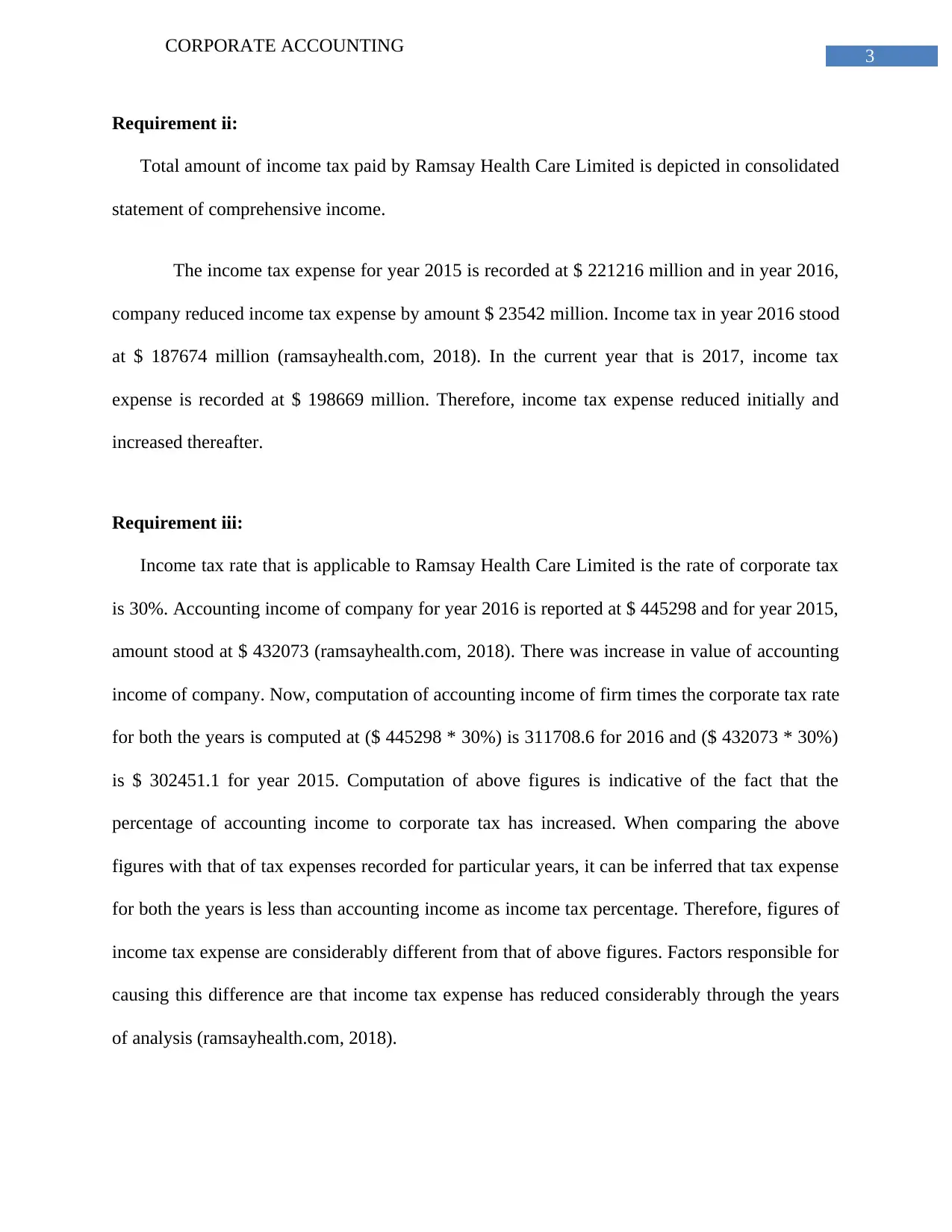
3
CORPORATE ACCOUNTING
Requirement ii:
Total amount of income tax paid by Ramsay Health Care Limited is depicted in consolidated
statement of comprehensive income.
The income tax expense for year 2015 is recorded at $ 221216 million and in year 2016,
company reduced income tax expense by amount $ 23542 million. Income tax in year 2016 stood
at $ 187674 million (ramsayhealth.com, 2018). In the current year that is 2017, income tax
expense is recorded at $ 198669 million. Therefore, income tax expense reduced initially and
increased thereafter.
Requirement iii:
Income tax rate that is applicable to Ramsay Health Care Limited is the rate of corporate tax
is 30%. Accounting income of company for year 2016 is reported at $ 445298 and for year 2015,
amount stood at $ 432073 (ramsayhealth.com, 2018). There was increase in value of accounting
income of company. Now, computation of accounting income of firm times the corporate tax rate
for both the years is computed at ($ 445298 * 30%) is 311708.6 for 2016 and ($ 432073 * 30%)
is $ 302451.1 for year 2015. Computation of above figures is indicative of the fact that the
percentage of accounting income to corporate tax has increased. When comparing the above
figures with that of tax expenses recorded for particular years, it can be inferred that tax expense
for both the years is less than accounting income as income tax percentage. Therefore, figures of
income tax expense are considerably different from that of above figures. Factors responsible for
causing this difference are that income tax expense has reduced considerably through the years
of analysis (ramsayhealth.com, 2018).
CORPORATE ACCOUNTING
Requirement ii:
Total amount of income tax paid by Ramsay Health Care Limited is depicted in consolidated
statement of comprehensive income.
The income tax expense for year 2015 is recorded at $ 221216 million and in year 2016,
company reduced income tax expense by amount $ 23542 million. Income tax in year 2016 stood
at $ 187674 million (ramsayhealth.com, 2018). In the current year that is 2017, income tax
expense is recorded at $ 198669 million. Therefore, income tax expense reduced initially and
increased thereafter.
Requirement iii:
Income tax rate that is applicable to Ramsay Health Care Limited is the rate of corporate tax
is 30%. Accounting income of company for year 2016 is reported at $ 445298 and for year 2015,
amount stood at $ 432073 (ramsayhealth.com, 2018). There was increase in value of accounting
income of company. Now, computation of accounting income of firm times the corporate tax rate
for both the years is computed at ($ 445298 * 30%) is 311708.6 for 2016 and ($ 432073 * 30%)
is $ 302451.1 for year 2015. Computation of above figures is indicative of the fact that the
percentage of accounting income to corporate tax has increased. When comparing the above
figures with that of tax expenses recorded for particular years, it can be inferred that tax expense
for both the years is less than accounting income as income tax percentage. Therefore, figures of
income tax expense are considerably different from that of above figures. Factors responsible for
causing this difference are that income tax expense has reduced considerably through the years
of analysis (ramsayhealth.com, 2018).
Paraphrase This Document
Need a fresh take? Get an instant paraphrase of this document with our AI Paraphraser
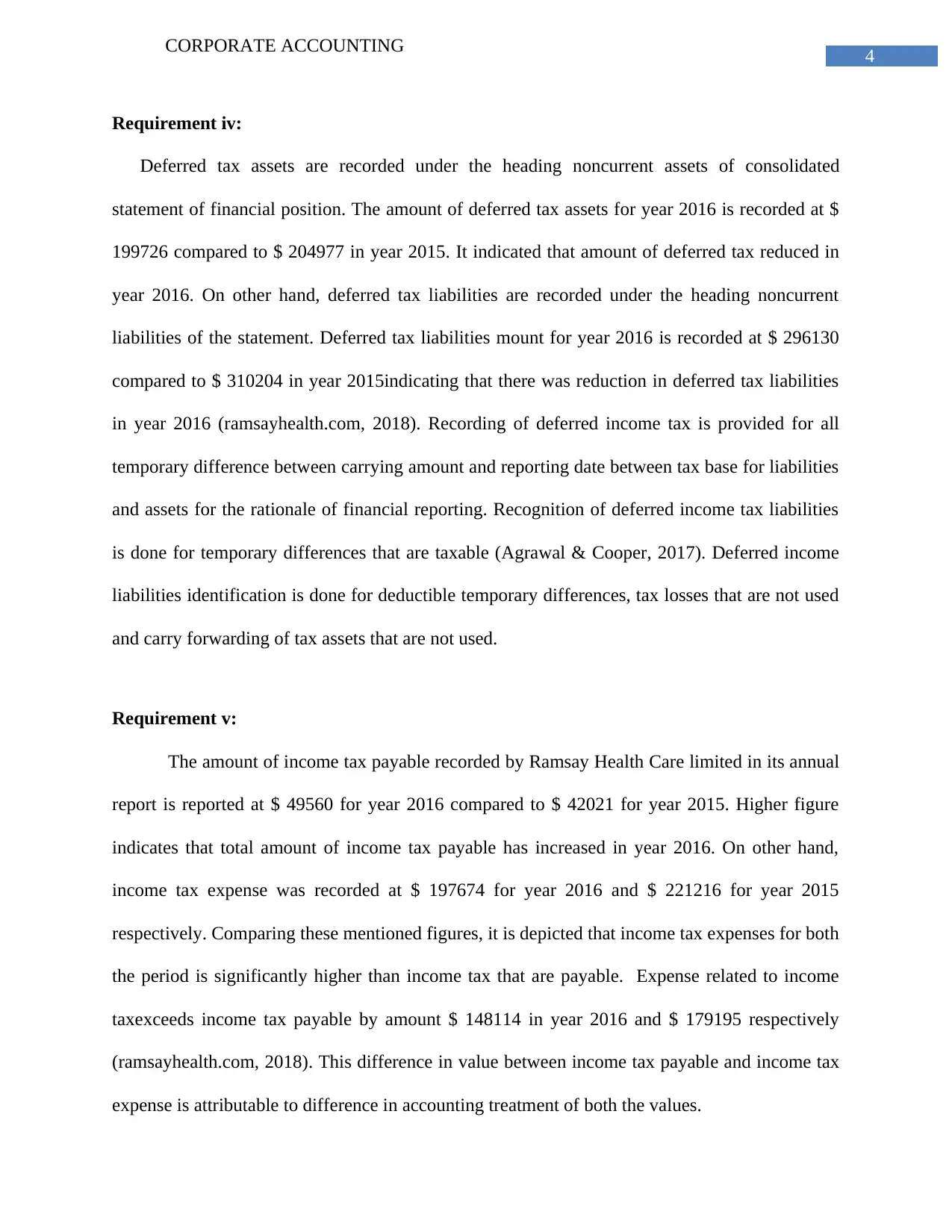
4
CORPORATE ACCOUNTING
Requirement iv:
Deferred tax assets are recorded under the heading noncurrent assets of consolidated
statement of financial position. The amount of deferred tax assets for year 2016 is recorded at $
199726 compared to $ 204977 in year 2015. It indicated that amount of deferred tax reduced in
year 2016. On other hand, deferred tax liabilities are recorded under the heading noncurrent
liabilities of the statement. Deferred tax liabilities mount for year 2016 is recorded at $ 296130
compared to $ 310204 in year 2015indicating that there was reduction in deferred tax liabilities
in year 2016 (ramsayhealth.com, 2018). Recording of deferred income tax is provided for all
temporary difference between carrying amount and reporting date between tax base for liabilities
and assets for the rationale of financial reporting. Recognition of deferred income tax liabilities
is done for temporary differences that are taxable (Agrawal & Cooper, 2017). Deferred income
liabilities identification is done for deductible temporary differences, tax losses that are not used
and carry forwarding of tax assets that are not used.
Requirement v:
The amount of income tax payable recorded by Ramsay Health Care limited in its annual
report is reported at $ 49560 for year 2016 compared to $ 42021 for year 2015. Higher figure
indicates that total amount of income tax payable has increased in year 2016. On other hand,
income tax expense was recorded at $ 197674 for year 2016 and $ 221216 for year 2015
respectively. Comparing these mentioned figures, it is depicted that income tax expenses for both
the period is significantly higher than income tax that are payable. Expense related to income
taxexceeds income tax payable by amount $ 148114 in year 2016 and $ 179195 respectively
(ramsayhealth.com, 2018). This difference in value between income tax payable and income tax
expense is attributable to difference in accounting treatment of both the values.
CORPORATE ACCOUNTING
Requirement iv:
Deferred tax assets are recorded under the heading noncurrent assets of consolidated
statement of financial position. The amount of deferred tax assets for year 2016 is recorded at $
199726 compared to $ 204977 in year 2015. It indicated that amount of deferred tax reduced in
year 2016. On other hand, deferred tax liabilities are recorded under the heading noncurrent
liabilities of the statement. Deferred tax liabilities mount for year 2016 is recorded at $ 296130
compared to $ 310204 in year 2015indicating that there was reduction in deferred tax liabilities
in year 2016 (ramsayhealth.com, 2018). Recording of deferred income tax is provided for all
temporary difference between carrying amount and reporting date between tax base for liabilities
and assets for the rationale of financial reporting. Recognition of deferred income tax liabilities
is done for temporary differences that are taxable (Agrawal & Cooper, 2017). Deferred income
liabilities identification is done for deductible temporary differences, tax losses that are not used
and carry forwarding of tax assets that are not used.
Requirement v:
The amount of income tax payable recorded by Ramsay Health Care limited in its annual
report is reported at $ 49560 for year 2016 compared to $ 42021 for year 2015. Higher figure
indicates that total amount of income tax payable has increased in year 2016. On other hand,
income tax expense was recorded at $ 197674 for year 2016 and $ 221216 for year 2015
respectively. Comparing these mentioned figures, it is depicted that income tax expenses for both
the period is significantly higher than income tax that are payable. Expense related to income
taxexceeds income tax payable by amount $ 148114 in year 2016 and $ 179195 respectively
(ramsayhealth.com, 2018). This difference in value between income tax payable and income tax
expense is attributable to difference in accounting treatment of both the values.
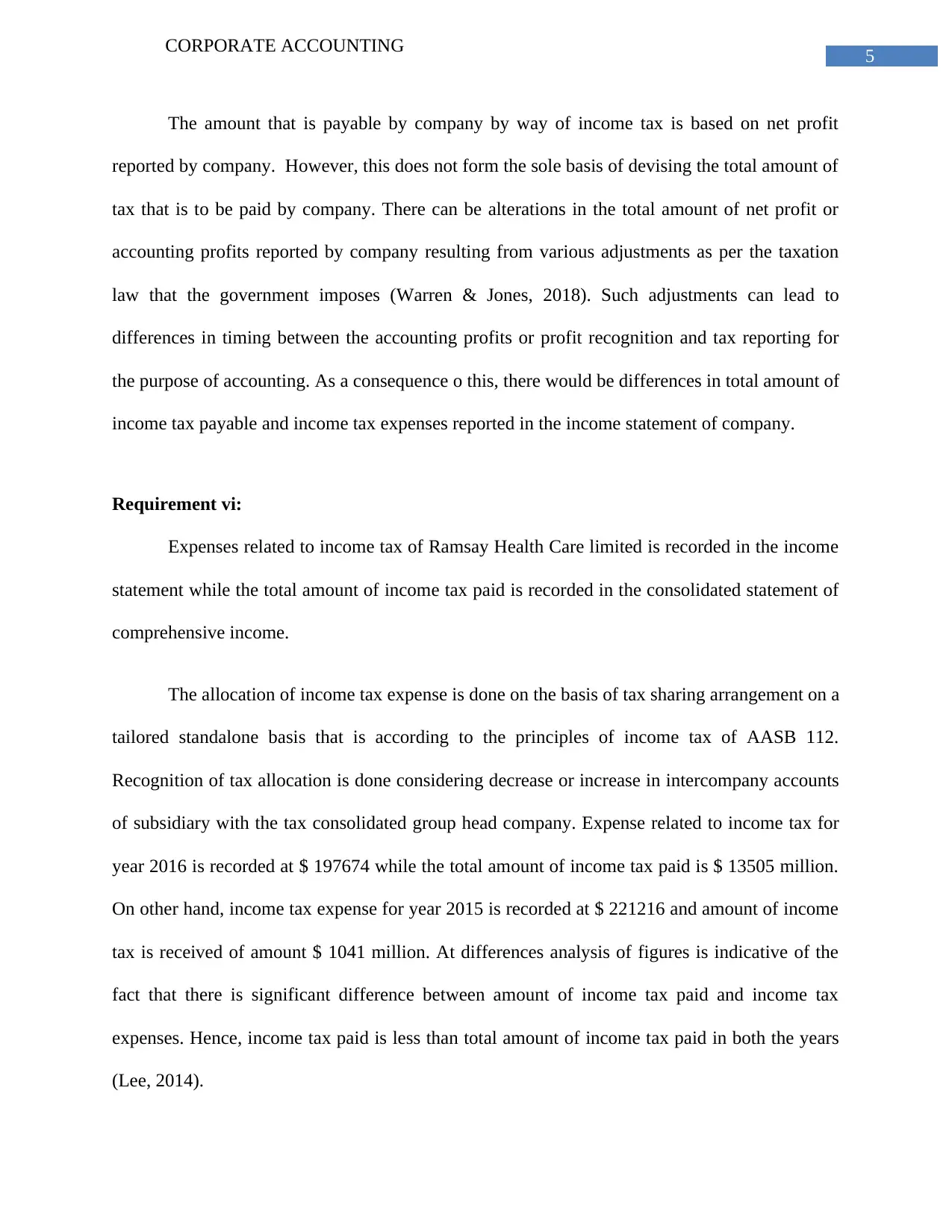
5
CORPORATE ACCOUNTING
The amount that is payable by company by way of income tax is based on net profit
reported by company. However, this does not form the sole basis of devising the total amount of
tax that is to be paid by company. There can be alterations in the total amount of net profit or
accounting profits reported by company resulting from various adjustments as per the taxation
law that the government imposes (Warren & Jones, 2018). Such adjustments can lead to
differences in timing between the accounting profits or profit recognition and tax reporting for
the purpose of accounting. As a consequence o this, there would be differences in total amount of
income tax payable and income tax expenses reported in the income statement of company.
Requirement vi:
Expenses related to income tax of Ramsay Health Care limited is recorded in the income
statement while the total amount of income tax paid is recorded in the consolidated statement of
comprehensive income.
The allocation of income tax expense is done on the basis of tax sharing arrangement on a
tailored standalone basis that is according to the principles of income tax of AASB 112.
Recognition of tax allocation is done considering decrease or increase in intercompany accounts
of subsidiary with the tax consolidated group head company. Expense related to income tax for
year 2016 is recorded at $ 197674 while the total amount of income tax paid is $ 13505 million.
On other hand, income tax expense for year 2015 is recorded at $ 221216 and amount of income
tax is received of amount $ 1041 million. At differences analysis of figures is indicative of the
fact that there is significant difference between amount of income tax paid and income tax
expenses. Hence, income tax paid is less than total amount of income tax paid in both the years
(Lee, 2014).
CORPORATE ACCOUNTING
The amount that is payable by company by way of income tax is based on net profit
reported by company. However, this does not form the sole basis of devising the total amount of
tax that is to be paid by company. There can be alterations in the total amount of net profit or
accounting profits reported by company resulting from various adjustments as per the taxation
law that the government imposes (Warren & Jones, 2018). Such adjustments can lead to
differences in timing between the accounting profits or profit recognition and tax reporting for
the purpose of accounting. As a consequence o this, there would be differences in total amount of
income tax payable and income tax expenses reported in the income statement of company.
Requirement vi:
Expenses related to income tax of Ramsay Health Care limited is recorded in the income
statement while the total amount of income tax paid is recorded in the consolidated statement of
comprehensive income.
The allocation of income tax expense is done on the basis of tax sharing arrangement on a
tailored standalone basis that is according to the principles of income tax of AASB 112.
Recognition of tax allocation is done considering decrease or increase in intercompany accounts
of subsidiary with the tax consolidated group head company. Expense related to income tax for
year 2016 is recorded at $ 197674 while the total amount of income tax paid is $ 13505 million.
On other hand, income tax expense for year 2015 is recorded at $ 221216 and amount of income
tax is received of amount $ 1041 million. At differences analysis of figures is indicative of the
fact that there is significant difference between amount of income tax paid and income tax
expenses. Hence, income tax paid is less than total amount of income tax paid in both the years
(Lee, 2014).
⊘ This is a preview!⊘
Do you want full access?
Subscribe today to unlock all pages.

Trusted by 1+ million students worldwide
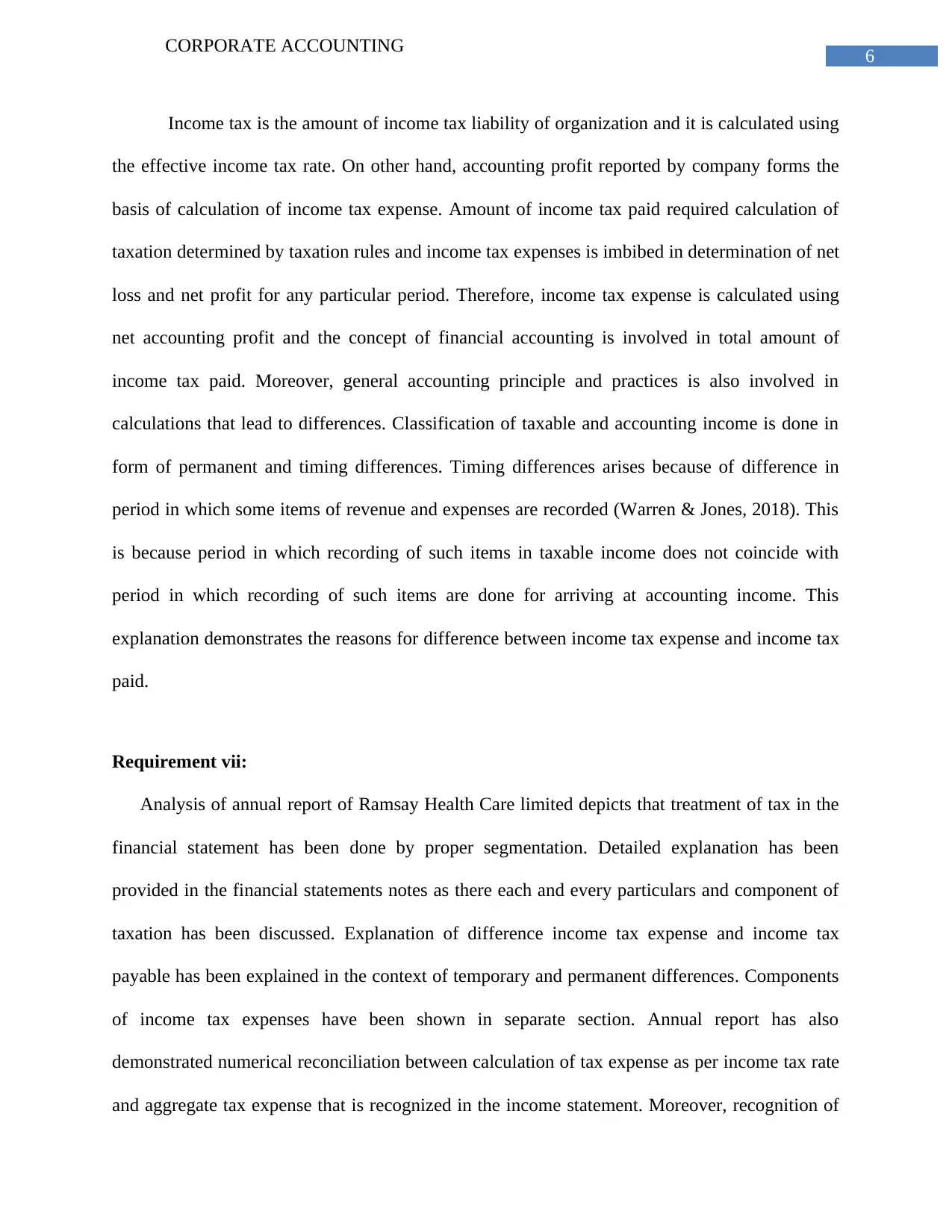
6
CORPORATE ACCOUNTING
Income tax is the amount of income tax liability of organization and it is calculated using
the effective income tax rate. On other hand, accounting profit reported by company forms the
basis of calculation of income tax expense. Amount of income tax paid required calculation of
taxation determined by taxation rules and income tax expenses is imbibed in determination of net
loss and net profit for any particular period. Therefore, income tax expense is calculated using
net accounting profit and the concept of financial accounting is involved in total amount of
income tax paid. Moreover, general accounting principle and practices is also involved in
calculations that lead to differences. Classification of taxable and accounting income is done in
form of permanent and timing differences. Timing differences arises because of difference in
period in which some items of revenue and expenses are recorded (Warren & Jones, 2018). This
is because period in which recording of such items in taxable income does not coincide with
period in which recording of such items are done for arriving at accounting income. This
explanation demonstrates the reasons for difference between income tax expense and income tax
paid.
Requirement vii:
Analysis of annual report of Ramsay Health Care limited depicts that treatment of tax in the
financial statement has been done by proper segmentation. Detailed explanation has been
provided in the financial statements notes as there each and every particulars and component of
taxation has been discussed. Explanation of difference income tax expense and income tax
payable has been explained in the context of temporary and permanent differences. Components
of income tax expenses have been shown in separate section. Annual report has also
demonstrated numerical reconciliation between calculation of tax expense as per income tax rate
and aggregate tax expense that is recognized in the income statement. Moreover, recognition of
CORPORATE ACCOUNTING
Income tax is the amount of income tax liability of organization and it is calculated using
the effective income tax rate. On other hand, accounting profit reported by company forms the
basis of calculation of income tax expense. Amount of income tax paid required calculation of
taxation determined by taxation rules and income tax expenses is imbibed in determination of net
loss and net profit for any particular period. Therefore, income tax expense is calculated using
net accounting profit and the concept of financial accounting is involved in total amount of
income tax paid. Moreover, general accounting principle and practices is also involved in
calculations that lead to differences. Classification of taxable and accounting income is done in
form of permanent and timing differences. Timing differences arises because of difference in
period in which some items of revenue and expenses are recorded (Warren & Jones, 2018). This
is because period in which recording of such items in taxable income does not coincide with
period in which recording of such items are done for arriving at accounting income. This
explanation demonstrates the reasons for difference between income tax expense and income tax
paid.
Requirement vii:
Analysis of annual report of Ramsay Health Care limited depicts that treatment of tax in the
financial statement has been done by proper segmentation. Detailed explanation has been
provided in the financial statements notes as there each and every particulars and component of
taxation has been discussed. Explanation of difference income tax expense and income tax
payable has been explained in the context of temporary and permanent differences. Components
of income tax expenses have been shown in separate section. Annual report has also
demonstrated numerical reconciliation between calculation of tax expense as per income tax rate
and aggregate tax expense that is recognized in the income statement. Moreover, recognition of
Paraphrase This Document
Need a fresh take? Get an instant paraphrase of this document with our AI Paraphraser
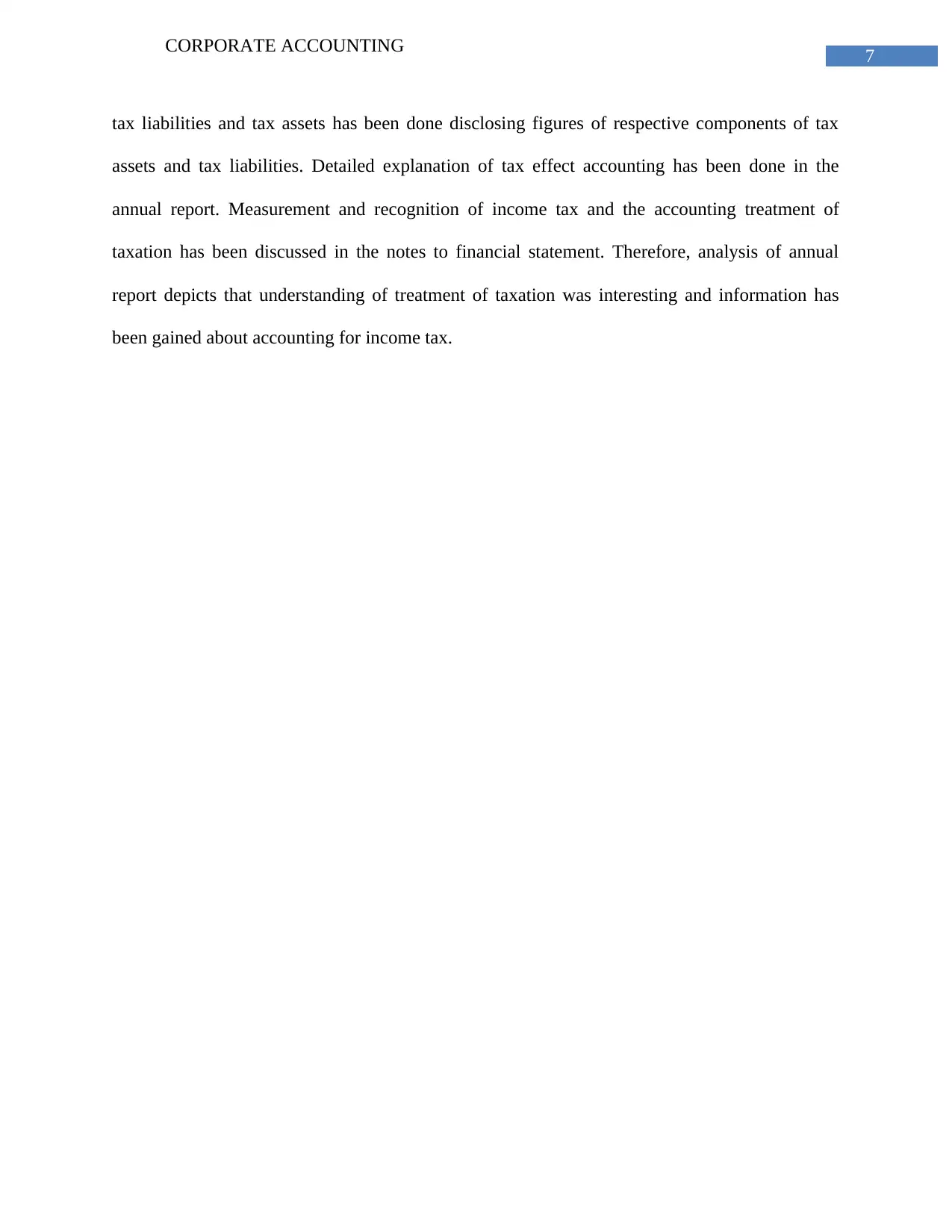
7
CORPORATE ACCOUNTING
tax liabilities and tax assets has been done disclosing figures of respective components of tax
assets and tax liabilities. Detailed explanation of tax effect accounting has been done in the
annual report. Measurement and recognition of income tax and the accounting treatment of
taxation has been discussed in the notes to financial statement. Therefore, analysis of annual
report depicts that understanding of treatment of taxation was interesting and information has
been gained about accounting for income tax.
CORPORATE ACCOUNTING
tax liabilities and tax assets has been done disclosing figures of respective components of tax
assets and tax liabilities. Detailed explanation of tax effect accounting has been done in the
annual report. Measurement and recognition of income tax and the accounting treatment of
taxation has been discussed in the notes to financial statement. Therefore, analysis of annual
report depicts that understanding of treatment of taxation was interesting and information has
been gained about accounting for income tax.
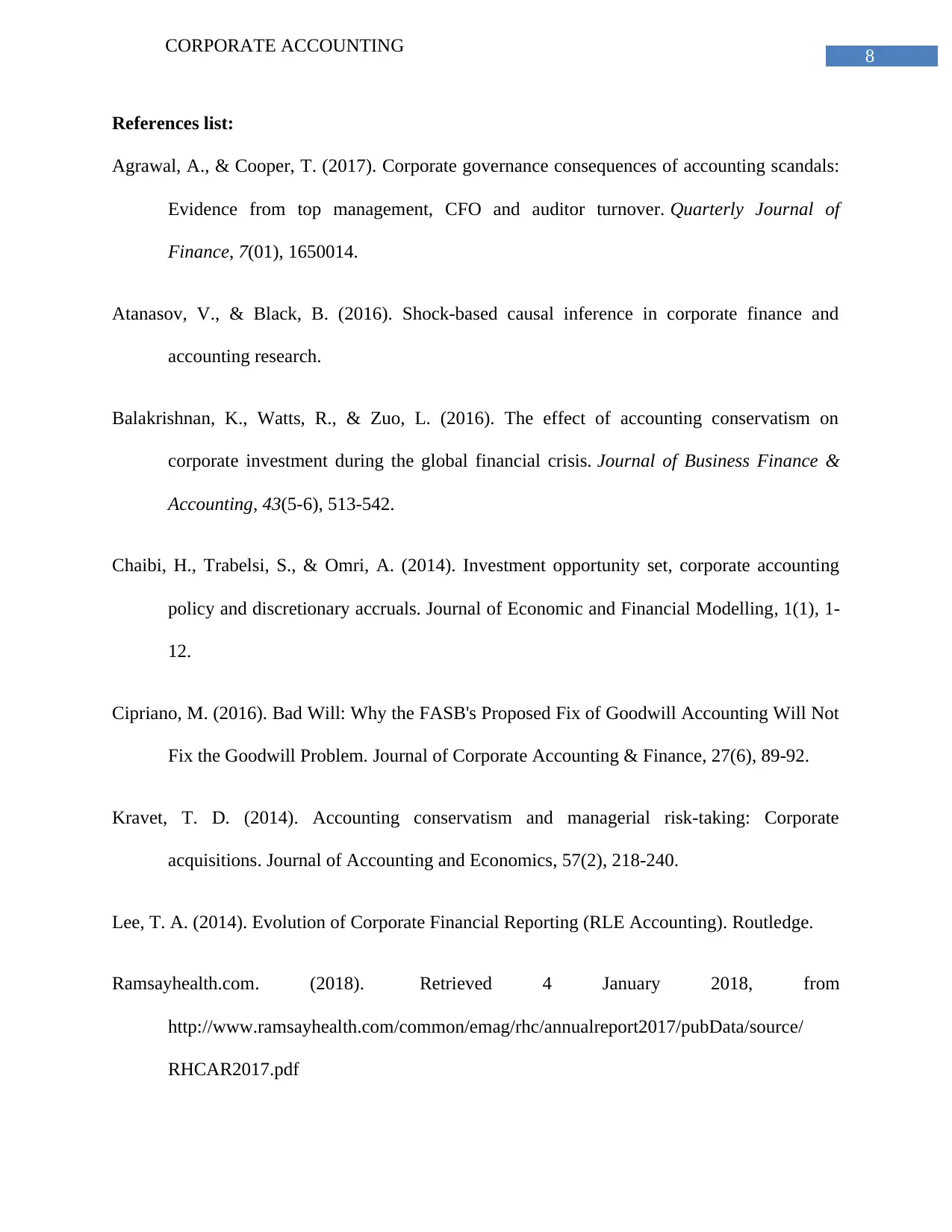
8
CORPORATE ACCOUNTING
References list:
Agrawal, A., & Cooper, T. (2017). Corporate governance consequences of accounting scandals:
Evidence from top management, CFO and auditor turnover. Quarterly Journal of
Finance, 7(01), 1650014.
Atanasov, V., & Black, B. (2016). Shock-based causal inference in corporate finance and
accounting research.
Balakrishnan, K., Watts, R., & Zuo, L. (2016). The effect of accounting conservatism on
corporate investment during the global financial crisis. Journal of Business Finance &
Accounting, 43(5-6), 513-542.
Chaibi, H., Trabelsi, S., & Omri, A. (2014). Investment opportunity set, corporate accounting
policy and discretionary accruals. Journal of Economic and Financial Modelling, 1(1), 1-
12.
Cipriano, M. (2016). Bad Will: Why the FASB's Proposed Fix of Goodwill Accounting Will Not
Fix the Goodwill Problem. Journal of Corporate Accounting & Finance, 27(6), 89-92.
Kravet, T. D. (2014). Accounting conservatism and managerial risk-taking: Corporate
acquisitions. Journal of Accounting and Economics, 57(2), 218-240.
Lee, T. A. (2014). Evolution of Corporate Financial Reporting (RLE Accounting). Routledge.
Ramsayhealth.com. (2018). Retrieved 4 January 2018, from
http://www.ramsayhealth.com/common/emag/rhc/annualreport2017/pubData/source/
RHCAR2017.pdf
CORPORATE ACCOUNTING
References list:
Agrawal, A., & Cooper, T. (2017). Corporate governance consequences of accounting scandals:
Evidence from top management, CFO and auditor turnover. Quarterly Journal of
Finance, 7(01), 1650014.
Atanasov, V., & Black, B. (2016). Shock-based causal inference in corporate finance and
accounting research.
Balakrishnan, K., Watts, R., & Zuo, L. (2016). The effect of accounting conservatism on
corporate investment during the global financial crisis. Journal of Business Finance &
Accounting, 43(5-6), 513-542.
Chaibi, H., Trabelsi, S., & Omri, A. (2014). Investment opportunity set, corporate accounting
policy and discretionary accruals. Journal of Economic and Financial Modelling, 1(1), 1-
12.
Cipriano, M. (2016). Bad Will: Why the FASB's Proposed Fix of Goodwill Accounting Will Not
Fix the Goodwill Problem. Journal of Corporate Accounting & Finance, 27(6), 89-92.
Kravet, T. D. (2014). Accounting conservatism and managerial risk-taking: Corporate
acquisitions. Journal of Accounting and Economics, 57(2), 218-240.
Lee, T. A. (2014). Evolution of Corporate Financial Reporting (RLE Accounting). Routledge.
Ramsayhealth.com. (2018). Retrieved 4 January 2018, from
http://www.ramsayhealth.com/common/emag/rhc/annualreport2017/pubData/source/
RHCAR2017.pdf
⊘ This is a preview!⊘
Do you want full access?
Subscribe today to unlock all pages.

Trusted by 1+ million students worldwide
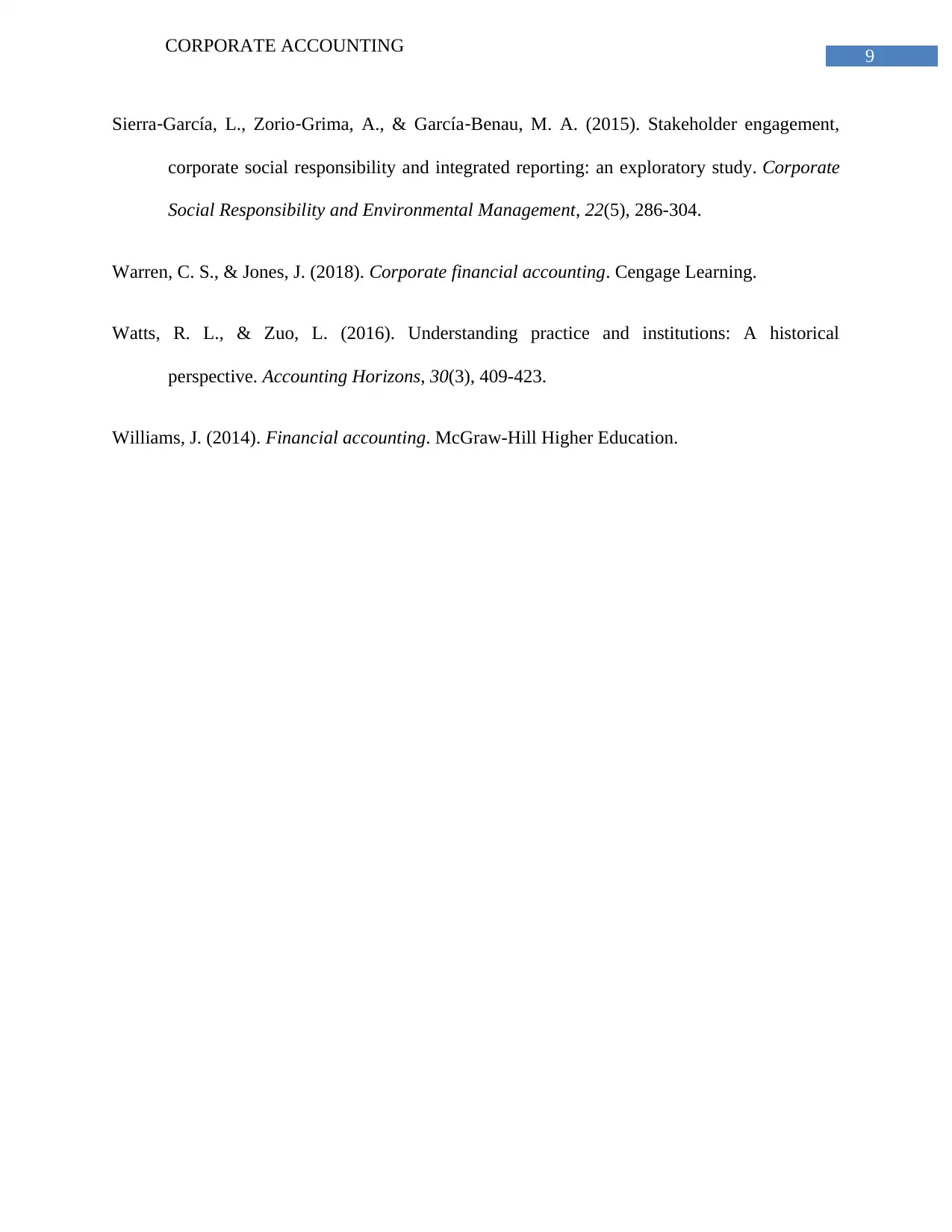
9
CORPORATE ACCOUNTING
Sierra‐García, L., Zorio‐Grima, A., & García‐Benau, M. A. (2015). Stakeholder engagement,
corporate social responsibility and integrated reporting: an exploratory study. Corporate
Social Responsibility and Environmental Management, 22(5), 286-304.
Warren, C. S., & Jones, J. (2018). Corporate financial accounting. Cengage Learning.
Watts, R. L., & Zuo, L. (2016). Understanding practice and institutions: A historical
perspective. Accounting Horizons, 30(3), 409-423.
Williams, J. (2014). Financial accounting. McGraw-Hill Higher Education.
CORPORATE ACCOUNTING
Sierra‐García, L., Zorio‐Grima, A., & García‐Benau, M. A. (2015). Stakeholder engagement,
corporate social responsibility and integrated reporting: an exploratory study. Corporate
Social Responsibility and Environmental Management, 22(5), 286-304.
Warren, C. S., & Jones, J. (2018). Corporate financial accounting. Cengage Learning.
Watts, R. L., & Zuo, L. (2016). Understanding practice and institutions: A historical
perspective. Accounting Horizons, 30(3), 409-423.
Williams, J. (2014). Financial accounting. McGraw-Hill Higher Education.
1 out of 10
Related Documents
Your All-in-One AI-Powered Toolkit for Academic Success.
+13062052269
info@desklib.com
Available 24*7 on WhatsApp / Email
![[object Object]](/_next/static/media/star-bottom.7253800d.svg)
Unlock your academic potential
Copyright © 2020–2025 A2Z Services. All Rights Reserved. Developed and managed by ZUCOL.





